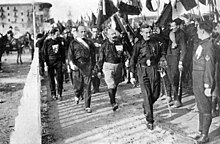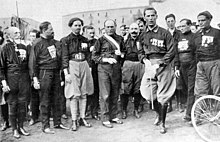
Back الزحف إلى روما Arabic Cola sobre Roma AST Марш на Рым Byelorussian Поход към Рим Bulgarian Marxa sobre Roma Catalan Pochod na Řím Czech Marsch auf Rom German Πορεία προς τη Ρώμη Greek Marŝo al Romo Esperanto Marcha sobre Roma Spanish
You can help expand this article with text translated from the corresponding article in Italian. (January 2024) Click [show] for important translation instructions.
|
| March on Rome | |||||||||
|---|---|---|---|---|---|---|---|---|---|
| Part of Civil unrest in Italy | |||||||||
  Benito Mussolini and his Blackshirts during the March | |||||||||
| |||||||||
| Belligerents | |||||||||
| Commanders and leaders | |||||||||
|
|
| ||||||||
| Political support | |||||||||
|
|
| ||||||||
The March on Rome (Italian: Marcia su Roma) was an organized mass demonstration in October 1922 which resulted in Benito Mussolini's National Fascist Party (Partito Nazionale Fascista, PNF) ascending to power in the Kingdom of Italy. In late October 1922, Fascist Party leaders planned a march on the capital. On 28 October, the fascist demonstrators and Blackshirt paramilitaries approached Rome; Prime Minister Luigi Facta wished to declare a state of siege, but this was overruled by King Victor Emmanuel III, who, fearing bloodshed, persuaded Facta to resign by threatening to abdicate. On 30 October 1922, the King appointed Mussolini as Prime Minister, thereby transferring political power to the fascists without armed conflict. On 31 October the fascist Blackshirts paraded in Rome, while Mussolini formed his coalition government.[1][2]
- ^ Lyttelton, Adrian (2004). The seizure of power: fascism in Italy 1919–1929. Totalitarian movements and political religions (Rev. ed.). London; New York: Routledge. pp. 75–77. ISBN 978-0-415-55394-0.
- ^ "March on Rome". Encyclopedia Britannica. Retrieved 2017-07-25.